Protocol for the Derivation of Environmental and Human ... - CCME
Protocol for the Derivation of Environmental and Human ... - CCME
Protocol for the Derivation of Environmental and Human ... - CCME
Create successful ePaper yourself
Turn your PDF publications into a flip-book with our unique Google optimized e-Paper software.
Part B, Section 7<br />
data, <strong>the</strong> Median Effects Method (MEM) (see Section 7.5.2.4) is preferable <strong>for</strong> guidelines derivation<br />
due to expected lower levels <strong>of</strong> uncertainty.<br />
<strong>Derivation</strong> Procedure<br />
The 25th percentile <strong>of</strong> <strong>the</strong> frequency distribution was chosen to represent <strong>the</strong> "no potential effects range"<br />
(NPER) based on <strong>the</strong> analysis <strong>of</strong> data from cadmium, pentachlorophenol, <strong>and</strong> arsenic. The NPER<br />
represents a point estimate in <strong>the</strong> distribution below which <strong>the</strong> proportion <strong>of</strong> definitive effects data (EC X ,<br />
LC X ) do not exceed "acceptable levels" (25%). Definitive effects data below <strong>the</strong> NPER are "minimal<br />
effects concentrations" that overlap <strong>the</strong> range <strong>of</strong> LOECs <strong>and</strong> NOECs used to determine <strong>the</strong> NPER.<br />
Norenberg-King (1988) used a 25% effect level as an estimate <strong>of</strong> <strong>the</strong> minimal effect level. Due to <strong>the</strong><br />
variability inherent in LOEC data <strong>and</strong> its proximity to NOEC estimates on distribution curves (<strong>of</strong>ten<br />
overlapping NOEC points [see Figure 11]), it is not considered a definitive effect, but ra<strong>the</strong>r as a<br />
potential effect estimate.<br />
The TEC is calculated using <strong>the</strong> following equation:<br />
TEC<br />
= NPER/UF<br />
where TEC = threshold effects concentration (mg/kg)<br />
NPER = no potential effects range (25th percentile <strong>of</strong> distribution) (mg/kg)<br />
UF = uncertainty factor (if needed)<br />
An uncertainty factor can be applied after examining <strong>the</strong> data used to estimate <strong>the</strong> NPER. A UF<br />
between one <strong>and</strong> five is suggested using <strong>the</strong> criteria below as a guide to determine <strong>the</strong> magnitude <strong>of</strong> <strong>the</strong><br />
uncertainty if:<br />
• only <strong>the</strong> minimum <strong>of</strong> three studies is available.<br />
• more than three studies are available, but fewer than three taxonomic groups are represented.<br />
• more than 25% <strong>of</strong> <strong>the</strong> data below <strong>the</strong> 25th percentile are definitive effects data.<br />
It should be noted that an uncertainty factor need not always be applied. Expert judgement should<br />
determine <strong>the</strong> magnitude <strong>of</strong> <strong>the</strong> uncertainty factor based on <strong>the</strong> above criteria. An uncertainty factor<br />
greater than five <strong>for</strong> o<strong>the</strong>r sources <strong>of</strong> uncertainty (e.g., field extrapolation) is not recommended since <strong>the</strong><br />
point <strong>of</strong> departure <strong>for</strong> <strong>the</strong> NPER is considered conservative <strong>and</strong> accounts <strong>for</strong> <strong>the</strong>se <strong>and</strong> o<strong>the</strong>r (e.g.,<br />
model error) uncertainties.<br />
The TEC should now be compared with <strong>the</strong> microbial value to determine <strong>the</strong> SQC SC <strong>for</strong> agricultural <strong>and</strong><br />
residential/parkl<strong>and</strong> l<strong>and</strong> uses (see Appendix A).<br />
54
















